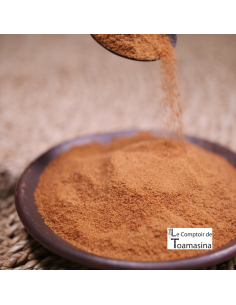Vanilla tahitensis from Papua is a variety of vanilla that has a rich and interesting history. Although more commonly known as Tahitian vanilla, this species of orchid is also grown in Papua New Guinea. Our best seller currently is the 5 pods and when you use its 5 vanillas or even the 10 pods you can make homemade vanilla powder.
Vanilla tahitensis is a hybrid, long considered a cross between Vanilla planifolia and Vanilla pompona. However, recent research suggests that it is more of a hybrid between Vanilla planifolia and another species close to Vanilla odorata.
The production of this species experienced strong growth until 2012, but declined again from 2013. Despite its relatively low production, Vanilla tahitensis stands out for its unique characteristics. Unlike the fragrans species, this vanilla is indehiscent, that is to say it does not open when ripe. It remains fleshy, giving it a distinctive texture and flavor.
Vanilla tahitensis is mainly produced in Tahiti, but also in Papua New Guinea, Indonesia, the Cook Islands and Niue. In Papua New Guinea, it is grown in ideal conditions to produce high quality vanilla.
The history of Vanilla tahitensis dates back to 1848, when Admiral F Hamelin brought vanilla plants from the Philippines to Tahiti. First cultivated in private gardens, Vanilla tahitensis underwent several crosses before giving birth to “Vanilla x Tahitensis”. Mass production of Vanilla tahitensis began in 1880.
The production of Vanilla tahitensis in Papua New Guinea is a complex process that requires special attention.
Papua New Guinea ranks fifth in the world in terms of vanilla bean production, with an estimated 495 tonnes per year.
Vanilla farming in Papua New Guinea is mainly carried out by small-scale farmers who grow vanilla under ideal conditions to produce high quality vanilla.
You should know that it takes 3 years for vanilla plants to produce a vanilla flower. Generally the first flowers arrive a few months after the dry season due to water shock.
Vanilla production begins with the planting of the Vanilla tahitensis orchid. Vanilla plants are typically grown on stakes and require partial shade for optimal growth. After planting, it takes about three years for vanilla plants to start producing pods.
Pollination of vanilla flowers is a crucial stage of production. As vanilla flowers only open for a short time, pollination must be done by hand to ensure maximum pod production.
Once the vanilla pods are ripe, they are harvested by hand. The pods are then blanched, fermented and dried, a process that can take several months. This processing process gives the vanilla beans their characteristic aroma.
Finally, the vanilla beans are sorted, packaged and ready to be sold in the market. Papua New Guinea vanilla is valued for its unique flavor and is used in various products including perfumes, food products and beverages.
Vanilla tahitensis is unique and has received numerous awards of excellence during agricultural competitions. Its powerful fragrance and rarity enhances desserts and preparations of all kinds. In addition, the health benefits of Vanilla tahitensis are recognized. It is appreciated not only for its taste, but also for its health benefits.
The world of vanilla is great, planifolia and Tahitensis vanilla pods will have the same story in Papua and since 2019, vanilla from Papua which will compete with planifolia bourbon vanilla from Madagascar.
Since 2010, Le Comptoir de Toamasina has been offering you the most beautiful vanilla pods.

























